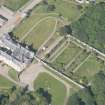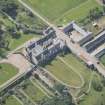Pricing Change
New pricing for orders of material from this site will come into place shortly. Charges for supply of digital images, digitisation on demand, prints and licensing will be altered.
Sandside House
Cross Incised Stone (Early Medieval), Pictish Symbol Stone(S) (Pictish)
Site Name Sandside House
Classification Cross Incised Stone (Early Medieval), Pictish Symbol Stone(S) (Pictish)
Canmore ID 7247
Site Number NC96NE 10
NGR NC 95193 65169
NGR Description NC 9519 6517 and NC 9522 6518
Datum OSGB36 - NGR
Permalink http://canmore.org.uk/site/7247
- Council Highland
- Parish Reay
- Former Region Highland
- Former District Caithness
- Former County Caithness
Sandside House 1, Caithness: Pictish symbol stone
Measurements: H 1.44m, W 0.89m, D 0.10m
Stone type: sandstone
Place of discovery: NC 951 651
Present location: fixed (upside down) to a garden wall at the rear of the house.
Evidence for discovery: found around 1850 ‘near the site of an ancient settlement’ on the sandy links close to the shore, the stone was used as part of the covering of the mill lade at Sandside Farm. In September 1889 it was extracted and taken to Sandside House.
Present condition: good.
Description
Finely incised on a smooth broad face of the slab are the triple oval symbol above a disc with indented rectangle, a mirror and a comb (no teeth depicted). Within the disc of the disc with indented rectangle there is a double circle offset from the centre of the disc.
Date: seventh century.
Compiled by A Ritchie 2016
Sandside House 2, Caithness, fragment of carved stone
Measurements: L 0.46m, W 0.38m
Stone type: sandstone
Place of discovery: NC 951 651
Present location: Sandside House.
Evidence for discovery: found amongst rubble near the house.
Present condition: broken.
Description
An enigmatic fragment incised with what may represent the arm of an encircled cross.
Date: uncertain.
Compiled by A Ritchie 2016
Shurrery, Caithness, cross-slab
Measurements: H 0.74m, W 0.23m, D 0.20m
Stone type: sandstone
Place of discovery: ND 0408 5783
Present location: Sandside House, against a wall in front of the house.
Evidence for discovery: found in the first decade of the 20th century built into a stone dyke near Shurrery and thought to have come from a chapel site at Tigh a’ Bheannaich, the slab was taken to Sandside House by 1910. Sometime later the date 1911 was cut at the base of the stone.
Present condition: good.
Description
Finely pecked lines define a simple encircled cross set on a splayed shaft, and below there is a plain circle almost the entire width of the slab. Despite it being a perfect circle, there is no trace of a compass hole at the centre.
Date range: seventh or eighth century.
References: RCAHMS 1911, no 406; Blackie & Macaulay 1998: no 19.
Compiled by A Ritchie 2016
Field Visit (29 August 1910)
[Cross-incised stone] At Sandside House there is a stone incised with symbols, which was found built into a stone dyke near Shurrery, not far from Tigh a'Bheannaich, which was evidently the site of a chapel or religious foundation. It is a rectangular block of sandstone, 2' 5" in length, 9" in breadth, and 8" in thickness. On the face of the stone is incised a small stemmed circle or orb, 4" in diameter, containing an equal-armed cross. The stem is 3 1/2" in length, 1" in breadth where it joins the circle, and 1 1/2" at base. Beneath, and occupying the breadth of the stone, is a plain circle with a diameter of 8".
[Sandside House 1] Placed against a wall at the E. side of Sandside House, and set within a wooden frame, is another sculptured slab. It was found about fifty years ago, near the site of an ancient settlement on the sand links by the sea shore at Sandside, and was subsequently used to cover a mill-lade where a road crossed, in which position it remained until September 1889, when it attracted the notice of Mr Pilkington, the proprietor of Sandside, during some repairs to the mill-lade, and who removed it for preservation to Sandside House. It is a rectangular slab of the hard sandstone of the district, 4' 8 1/2" long by 1' 11 1/2" wide by 3 1/2" thick, sculptured on one face with incised lines, thus: (front) at the top, a symbol (unnoticed previous to the discovery of this stone), consisting of a horizontal row of three flattened ovals, joined together in the middle by pairs of small circles, and having a double outline at the tops and bottoms of the ovals; below this, the mirror-case symbol; and at the bottom, the mirror-and-comb symbol.
Visited by RCAHMS (AOC) 29 August 1910.
[Two photographs from this visit in Curle's journal MS 36/19]
Field Visit (25 November 1964)
Both stones are as described.
Surveyed at 1:2500
Visited by OS (N K B) 25 November 1964.
Desk Based Assessment (1964)
NC96NE 10.00 951 651
NC96NE 10.01 NC 9519 6517 incised stone
NC96NE 10.02 NC 9522 6518. Pictish symbol stone
(A: NC 9522 6518 and B: NC 9519 6517 Symbol Stones (NR) (moved)
OS 6" map, (1967)
A: A Class I symbol stone found about 1853 on the links by the shore at Sandside (NC 95 65) near an ancient settlement (presumably NC96NE 9) and removed firstly to Sandside Farm to cover a mill-lade, and then, in 1889 to Sandside House where it is placed within a wooden frame against a wall at the east side. It is a rectangular slab of local sandstone 4ft 8 1/2ins long, by 1ft 11 1/2 ins wide and 3 1/2ins thick, with incised symbols on one face only. The symbols are a horizontal row of three conjoined ovals, a mirror-case and, at the bottom, a mirror and comb.
B: A rectangular sandstone block 2ft 5ins long, by 9ins broad and 8ins thick which was found built into a stone dyke not far from Tigh a' Bheannaich (ND05NW 9), near Shurrery (ND 03 57). On the face of the stone is incised a small, stemmed circle or orb 4ins in diameter containing an equal-armed cross. The stem is 3 1/2ins long and 1 - 1 1/2ins broach. Beneath, and occupying the breadth of the stone, is a plain circle with a diameter of 8ins.
Information from OS c.1964
J R Allen and J Anderson 1903; RCAHMS 1911, visited 1910.
Field Visit (8 September 1981)
The symbol stones are as described and illustrated.
Visited by OS (J B) 8 September 1981.
Reference (1996)
Only a detailed survey of Sandside House (NC96NE 11.00) would reveal whether any portions of these [stones] are incorporated in the present fabric.
E Beaton 1996.
Reference (1997)
[Sandside House 1] Class I symbol stone showing a triple-oval with a divided mirror-case and a mirror-and-comb.
A Mack 1997.






















































